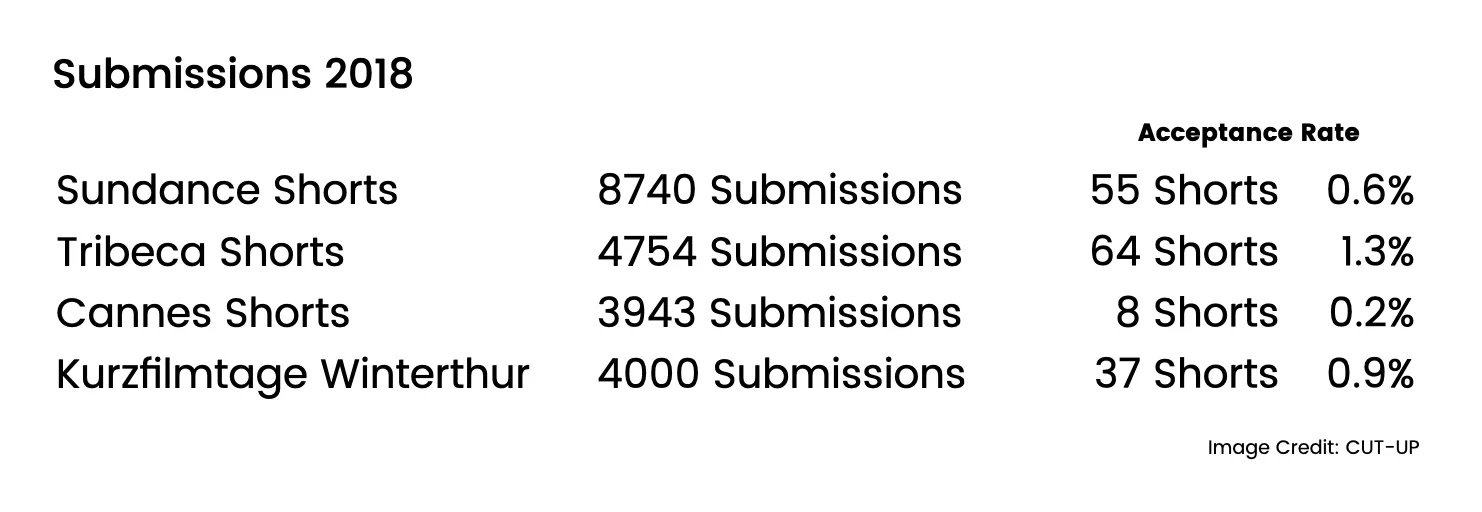How much budget do I need for a festival run?
Our recommendations for international festival distribution budgets, in relation to different strategies and goals.
Engrossed in shooting, postproduction, distribution and marketing, filmmakers tend to underestimate the efforts and budgets needed for a festival run. For most short films festivals still are the main distribution option. Besides the opportunity to gain professional credibility, being selected at festivals results in huge benefits like networking with the industry and fellow filmmakers, awards and cash prizes, and even funding opportunities for future projects. But it should be mentioned, that not every short film is automatically suitable for festival distribution. A presentation in an art gallery context, a social media campaign supporting the theme of the film, or even a direct online release might also be options to consider.
The conventional strategy: Premiere at a big festival
Image Credit: Short of the Week
A conventional strategy means aiming for World, International or Country Premieres at renowned festivals, followed by selections at midrange to smaller festivals later on. Releases on VOD, TV or any other channel are planned after several months of festival screenings, to not jeopardize the premiere requirements of the festivals. The public online release can be expected after two to three years.
Famous festivals often are expensive to submit to. We recommend budgets from 2500 to 3000 CHF/$ in submission fees for a fiction short, which allows 160 to 240 submissions, and a festival period of about two years. A smaller budget means a shorter and smaller reach.
Animation, documentary and genre shorts are slightly better off: the budget can be a little lower, as there are more specialized festivals with free submission. Also the chances of selections are higher, because fewer films are submitted in these categories.
If films are selected or are awarded at certain festivals in Europe, it qualifies the film for bigger film awards (e.g. BAFTA, Académie des César, Goya, European Film Awards, European Animation Award etc.). This is one of the reasons why European festivals are more strict in their premiere requirements than US film festivals. Also they are out to discover new films and talents, and want to be the first to present them, that’s what makes their festival unique. Some offer prize money and are covering for the accommodation of the filmmakers in exchange for the exclusivity. Not having a festival strategy and releasing the film online too early, excludes your film from these festivals.
Be Everywhere all at Once
Image Credit: Short of the Week
Another pretty powerful strategy for a festival run is Be Everywhere all at Once. You focus less on where the premiere takes place: the goal is to spread your work. In a first round you already submit to quite a bunch of festivals whether big or small (50 to 100), and see where you end up. In the second round, you tweak the strategy and submit to similar festivals as those that have already responded to your film.
You can even try to see how far your film travels when submitting to free or cheap festivals only. Some famous and big festivals, especially in Europe, are still free to submit! This option is recommended if you have a tight budget, if you already submitted a lot, or if your film is an undergraduate work and you want to gain some experience with festivals.
With the Be Everywhere all at Once strategy you can plan your online release early, and still continue to submit to festivals. According to Short of the Week, more than 70% of the festivals allow films to be published. To our experience even famous festivals like Sundance, Clermont Ferrand or Tampere program online released shorts in competitions, and even award them. You might want to check our article When is the best moment to release your short online.
Acceptance Rates
A common misjudgment is, how many festivals you need to apply to, in order to get selected to one. Nearly every filmmaker gets insecure when receiving the first rejections. Thinking about how many great shorts are out there, and how challenging it is for programmers to create screening programs that fit their audience, one realizes that rejections are part of the game.
Here are some expamples of how many submissions the big festivals receive, and how many they actually select for their competitions:
Even very successful films receive a lot of rejections. One of our shorts, winner of a BAFTA award and shortlisted for an Academy Award, played at more than 110 festivals and received 26 awards. The short was submitted to more than 300 festivals, which means there have been roughly 200 rejections.
This list gives you a rough idea about how many submissions can lead to which percentage of acceptances.
We consider acceptance rates between 10% to 20% as quite good, anything above 20% is fantastic. With a strong strategy one can hope for higher acceptance rates. More so, as you will only submit to festivals really worth submitting to, specifically for your film. You will spend the budget in the best way possible.
by Andrea Sponring & Lilla Puskás
2018 © www.cut-up.ch, Switzerland. Free for fair use: if you quote, credit.
Last updated: May 2022






